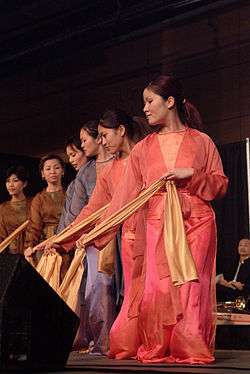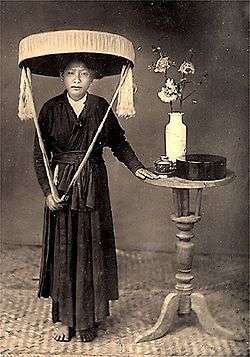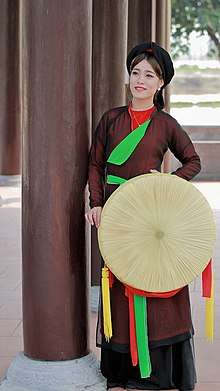Áo tứ thân
The áo tứ thân (Vietnamese: [ʔǎːw tɨ̌ tʰən], four-part dress) is one of several traditional Vietnamese costumes. It is related to the áo ngũ thân which translates as "5-part dress".[1]

History

The áo tứ thân was worn widely by women centuries before the áo dài. As Vietnam expanded southward, áo tứ thân gradually became associated specifically with northern women.
Dress

The áo tứ thân was the dress of peasant women, which explains why it was often made with plain fabric in dark colors, except when it was to be worn at special occasions such as festivals or weddings. Regardless of its many different forms, the basic Áo tứ thân consists of:
- A flowing outer tunic, reaching almost to the floor. It is open at the front, like a jacket. At the waist the tunic splits into two flaps: a full flap in the back (made up of two flaps sewn together) and the two flaps in the front which are not sewn together but can be tied together or left dangling.
- A long skirt, worn under the tunic.
- Yếm, an ancient bodice worn as an undergarment by women. It comes in many fabrics and colors, worn under the skirt and outer tunic.
- A silk sash which is tied at the waist as a belt.
Áo tứ thân in modern-day Vietnam (worn almost exclusively in northern-related festivals) tends to be extremely colorful, using different hues throughout the dress, from the tunic to the bodice and the skirt.
Place in modern-day Vietnam
Áo tứ thân is now obsolete in terms of its daily use in Vietnam. However, it can be seen often in traditional occasions such as festivals, especially in northern Vietnam.
In southern Vietnam, the simpler silk two-piece ensemble áo bà ba is preferred for day-to-day use.